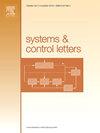具有同步随机跳变的分段确定性离散时间模型
IF 2.5
3区 计算机科学
Q3 AUTOMATION & CONTROL SYSTEMS
引用次数: 0
摘要
本文在建立连续时间分段确定性马尔可夫过程模型的基础上,提出了一种新的随机离散时间模型。离散时间动力学由确定性运动和随机跳跃组成。确定性运动由漂移矢量场的方向给出。随机跃迁由有限个独立的计数过程触发,相应的状态跃迁由跃迁向量场给出。人们可以把离散时间系统看作是带有漂移的输入仿射,其中计数过程充当跳跃向量场方向上的输入。在每个时间步长中,我们允许激活多个跳跃向量场,这与相应的连续时间模型不同,在连续时间模型中,几乎可以肯定的是,每个时间瞬间只发生一个跳跃。所提出的离散时间模型还包括用户规定的步长,它允许对连续时间过程进行近似。在步长消失的极限下,离散时间模型的样本路径几乎肯定地收敛于连续时间分段确定性马尔可夫过程的样本路径。我们还描述了在线性漂移和跳跃向量场假设下模型的均方指数稳定性。研究结果应用于具有随机状态测量的线性离散状态反馈系统。本文章由计算机程序翻译,如有差异,请以英文原文为准。
A piecewise deterministic discrete-time model with simultaneous random jumps
In this paper, we propose a new stochastic discrete-time model, which is inspired by the established model of a continuous-time piecewise deterministic Markov process. The discrete-time dynamics consist of deterministic motion and random jumps. The deterministic motion is given by the direction of a drift vector field. The random jumps are triggered by a finite number of independent count processes and the corresponding state transitions are given by jump vector fields. One may think of the discrete-time system as an input-affine with drift, where the count processes act as inputs in the directions of the jump vector fields. In each time step, we allow an activation of multiple jump vector fields, which is different from the corresponding continuous-time model in which, almost surely, only one jump occurs at each time instant. The proposed discrete-time model also includes a user-prescribed step size, which allows approximations of continuous-time processes. In the limit of vanishing step size, the sample paths of the discrete-time model converge almost surely to the sample paths of a continuous-time piecewise deterministic Markov process. We also characterize mean-square exponential stability of the model under the assumption of linear drift and jump vector fields. The findings are applied to a linear discrete-time state-feedback system with random state measurements.
求助全文
通过发布文献求助,成功后即可免费获取论文全文。
去求助
来源期刊

Systems & Control Letters
工程技术-运筹学与管理科学
CiteScore
4.60
自引率
3.80%
发文量
144
审稿时长
6 months
期刊介绍:
Founded in 1981 by two of the pre-eminent control theorists, Roger Brockett and Jan Willems, Systems & Control Letters is one of the leading journals in the field of control theory. The aim of the journal is to allow dissemination of relatively concise but highly original contributions whose high initial quality enables a relatively rapid review process. All aspects of the fields of systems and control are covered, especially mathematically-oriented and theoretical papers that have a clear relevance to engineering, physical and biological sciences, and even economics. Application-oriented papers with sophisticated and rigorous mathematical elements are also welcome.
 求助内容:
求助内容: 应助结果提醒方式:
应助结果提醒方式:


